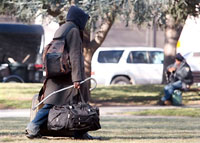United States
More than one in ten live in poverty
Article published on the 2008-08-28 Latest update 2008-08-28 13:07 TU
The numbers are based on 2007 data and show that more than one in ten people live below the poverty line, defined as an income of 21,000 dollars (14,000 euros) per year for a family of four. These numbers are slightly up from 2006, but show no “statistically significant” change, the report’s authors claim.
The number of people with no health insurance decreased in 2007, dropping to 45.7 million from 47 million the year before. Even though the number has gone down, it’s not enough to celebrate, said Paul Fronstin, a researcher at the Washington think-tank the Employee Benefits Research Institute.
“You have to remember that the numbers in the report are from last year,” Fronstin told French news agency AFP. "This year, Americans have been faced with record-high gasoline prices and rising food prices. Unemployment is also up, meaning fewer Americans have access to employer health benefits."
The report also shows that children are disproportionately affected by poverty, with 18 per cent of those under the age of 18 living in poverty, while only 11 per cent of adults and under 10 per cent of seniors do so.
Black people are most likely to live below the poverty line (24.5 per cent) followed by Hispanics (21.5 per cent). Asians (10.2 per cent) and non-Hispanic whites (8.2 per cent) have far lower poverty rates.
Both candidates in the US presidential campaign have made poverty and health insurance key issues. Barack Obama has proposed a national health insurance system open to those whose employers don’t provide them with a plan. McCain opposes Obama’s plan, prefering to help poorer families with financial incentives.







